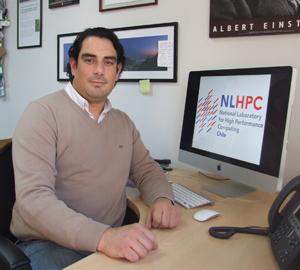The four-processor server will allow the lab to increase its computing capacity to meet the demand of companies and academic institutions.
Promote the use of technology of High Performance Computing (HPC) in industrial applications and satisfied national scientific demand for high performance computing. With these goals, the Center for Mathematical Modeling (CMM), at University of Chile formed the National Laboratory for High Performance Computing (NLHPC) which has become the most recognized services center of the country in this area.
Thanks to a frontier computer infrastructure and to a high quality offer of HPC’s services, the NLHPC seeks to increase, significantly, the impact of national scientific research, basic and applied, promoting linkages between research groups, the industry and the public sector.
That’s why Intel, seeking to be an ally in the promotion of HPC by academics and industry in general, decided to provide a server with 4 Xeon E7 processors at NLHPC. The equipment is added to the base installed by CMM, the largest of its kind in Chile. With this server, the lab was able to increase computing capacity to continue to lead the country through an initiative to meet the companies and academic institutions’ demand.
«In Chile, some areas of science as well as certain industries have reached a level of maturity that to remain competitive globally, require the use of technologies related to HPC , such as mining,» says Tomás Pérez-Acle, Deputy Director and Chief Operating Officer (COO) of NLHPC, Universidad de Chile. However, only large corporations in Chile such as Codelco, Copec and Arauco, have developed specific projects related to this matter and the main focus of the alliance is to encourage the use of this technology throughout the industry.
The collaborative project was finalized in May 2011 after a month of talks, says Eduardo Godoy, business development manager of Intel Chile. «We are very excited about this partnership because it has allowed us to help the industry to promote HPC and the benefits of this technology in various fields such as the optimization of resources.»
The infrastructure of this laboratory is based on Intel machines and the expectations for the next year is to pursue initiatives to further promote the use of HPC technology. «Today we have a computing capacity of 620 cores and the goal is to reach 2,000 cores to offer more and better solutions for both industry and the academy,» Perez-Acle stresses.
With this background was that by early 2010, the Programa de Investigación Asociativa of CONICYT called the First Contest of Centers for Major Equipment, to allocate about $ 4 million dollars. These funds were awarded to the University of Chile, which has pledged to invest some of those resources in institutions associated with this project, so they can also develop and contribute to HPC research for the country.
That’s when the need arose to have a powerful server capable of processing huge amounts of data. This is a server processor Xeon X7560 E7, a high performance machine, as it has a compute capacity of up to 8 cores. This is physically housed at the university but accessible via Internet for the industry to make use of it, says Godoy. Even, the equipment has been tested for the disciplines of meteorology, genomics and Climate achieving comprehensive and successful results.
Edition: Comunicaciones CMM
By Rita Núñez, Burson-Marsteller
Originally published at CMM – Center for Mathematical Modeling

